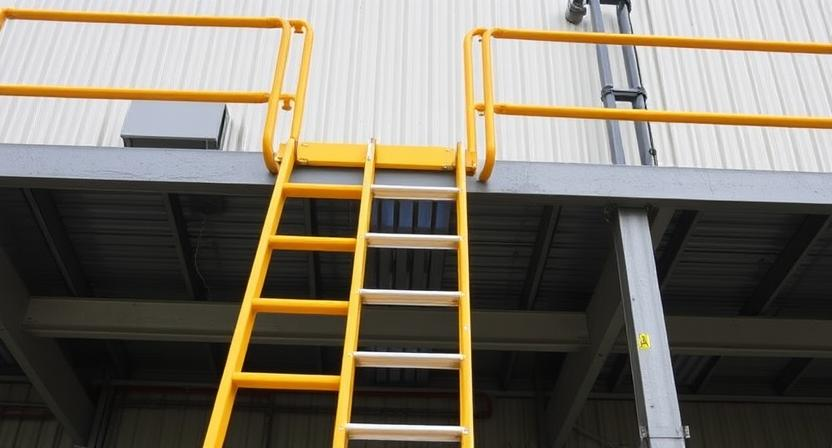
Safety ladders are indispensable tools in numerous high-risk environments, providing crucial support for accessing elevated areas safely. The importance of choosing the right safety ladder extends beyond functionality; it is ultimately about ensuring the well-being of employees and adhering to safety regulations. In this article, we will explore the essential considerations for selecting the best safety ladder for high-risk environments, emphasizing both safety and efficiency.
Introduction
In high-risk environments such as construction sites, warehouses, and industrial facilities, the role of a safety ladder cannot be overstated. These settings present unique challenges, including uneven surfaces, exposure to hazardous materials, and the need to perform tasks at significant heights. Choosing the right safety ladder is critical because it facilitates access to elevated areas and mitigates risks associated with working at heights. For industries dealing with heavy machinery, electrical installations, or construction, selecting a suitable ladder is vital. This article will explore key considerations when selecting the best safety ladder, ensuring worker safety and adherence to industry regulations.
Terms Explanation
Safety ladders come in various types, each designed for specific purposes and applications. Understanding these types and their specific features is crucial:
Extension Ladders: Designed for reaching significant heights, often used in construction and maintenance. They consist of multiple sections that slide past each other for adjustable height.
Step Ladders: Self-supporting with a hinged design, ideal for tasks requiring a stable platform at lower heights.
Platform Ladders: Feature an extended platform at the top, providing a larger standing area for tasks needing both hands free.
Specialized Ladders: Designed for unique applications and often incorporate specific features tailored to particular tasks.
Task Step Guide
The Importance of Selecting the Right Safety Ladder
Selecting an appropriate safety ladder is imperative in high-risk environments. The wrong choice can lead to accidents, injuries, fatalities, and have extensive implications for businesses in terms of productivity loss, legal liabilities, and reputation damage. Thus, choosing the right ladder is a significant decision not to be taken lightly.
Key Factors to Consider When Choosing a Safety Ladder
1. Height Requirements
One of the first considerations is determining the height requirements for the specific tasks. A ladder must provide adequate reach without compromising safety. Using a ladder too short forces workers to overreach, heightening fall risks, while an excessively tall ladder can be unwieldy and hazardous.
2. Material and Durability
Ladder construction material plays a significant role in its durability and suitability. Common materials include:
Fiberglass: Non-conductive, ideal for electrical work.
Aluminum: Lightweight, corrosion-resistant.
Wood: Traditional, but less durable in high-risk environments.
Choose a material aligning with work environment demands and the tasks performed.
| Material | Advantages | Limitations |
| Fiberglass | Non-conductive, strong | Heavier than aluminum |
| Aluminum | Lightweight, corrosion-resistant | Conductive |
| Wood | Affordable, non-conductive | Less durable, susceptible to rot |
3. Load Capacity and Stability
Load capacity determines the maximum weight the ladder can safely support, including the worker's weight and carried tools. Ensure the ladder's capacity exceeds the combined weight for safety and stability. Features like wide base supports and slip-resistant rungs enhance ladder stability.
4. Type of Ladder and Its Specific Features
Recognizing the types of ladders suited for specific applications is crucial. For instance, extension ladders for high places and step ladders for stable positions at lower heights. Specialized features like locking mechanisms and integrated safety rails enhance functionality and safety.
5. Environmental Considerations
Consider exposure to chemicals, moisture, and extreme temperatures. Ladders must withstand harsh conditions with protective coatings or materials resistant to corrosion and chemical damage for long-term safety and durability.
Different Types of Safety Ladders for High-Risk Environments
Extension Ladders
Suited for reaching high areas, common in construction, maintenance, and emergency responses. Key considerations include adjustable height and stability.
Step Ladders
Self-supporting, used for stable, lower-height tasks like painting and shelving. Important features include non-slip steps and a sturdy frame.
Platform Ladders
Offer a large standing area for tasks requiring free hands, like electrical work and maintenance. They provide greater comfort and support for prolonged use.
Specialized Ladders
Designed for unique applications with tailored features for safety and functionality. Examples include articulating ladders for uneven surfaces and cage ladders for industrial use.
Regulatory Standards and Certifications for Safety Ladders
OSHA Regulations for Ladder Safety
In the U.S., OSHA sets ladder safety regulations to protect workers from falls and injuries. Compliance includes ladder inspections and defect removal from service. Meeting OSHA requirements is crucial for legal adherence and worker safety.
ANSI Standards for Ladder Construction
ANSI standards ensure ladder safety through guidelines on materials, load capacity, and safety-enhancing features like slip-resistant rungs. Ladders meeting ANSI standards are certified, ensuring compliance with safety requirements.
International Standards and Certifications
Global standards from the International Organization for Standardization (ISO) and the European Committee for Standardization (CEN) guide ladder safety. These standards facilitate safety across different regions with guidelines on design, requirements, and testing methods.
Conclusion
Choosing the best safety ladder for high-risk environments requires careful consideration of multiple factors such as height needs, material durability, load capacity, ladder type, and environmental adaptability. Furthermore, compliance with regulatory standards and certifications, such as those from OSHA, ANSI, ISO, and CEN, is essential for maintaining safety and regulatory adherence. By prioritizing ladder selection and adhering to industry standards, businesses can ensure safer work environments, reduce accident risks, and enhance operational efficiency. Remember, the right safety ladder is a critical component in a comprehensive safety strategy that safeguards workers and business interests.

















